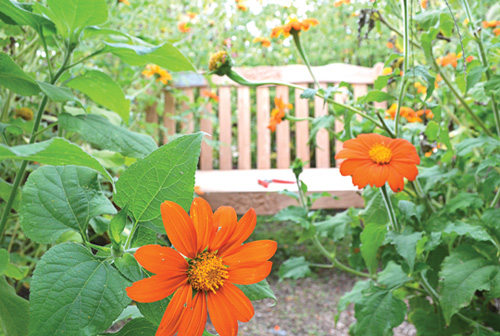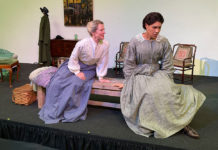Nourishment for both body and spirit
There is a magical garden tucked a few blocks from the center of Forestville that holds the spirit of the Sonoma County AIDS Food Bank.
The Food for Thought Healing Horticultural Garden was planted primarily as a source of high quality organic food for its clients, people living with disabling HIV and AIDS. But it has the more important purpose, according to FFT’s Client Services Manager Rachel Gardner, of being a beautiful environment, a place to walk, to sit and remember lost loved ones, and to grieve. A place where clients feel really cared for, and where they are allowed their dignity.
Gardner wanted to shift expectations of what a food bank is for the clients, from a place to pick up a bag of food to a community resource for healing. “The element of choice is key. In our society, which so values independence, it’s hard to ask for help, to admit that you are having a hard time feeding yourself and your family.” The garden helps the clients feel welcome, a big part of FFT’s intention to offer psychological and spiritual nourishment.
Gardner and FFT garden co-founder Doug Gosling met in the 1990s when they worked together at Henry House, a group home in Santa Rosa run by Face to Face Sonoma County AIDS Network. In 1999, with funding from Occidental Arts and Ecology Center, where Gosling has managed the gardens for more than 28 years, they created a completely organic garden surrounding the food bank building on Railroad Avenue.
Supplied with plant starts from the ‘mother garden’ at OAEC and maintained by Gosling with a volunteer staff, this garden grows an amazing diversity of plants, with annual vegetable plots, a fruit orchard, a raspberry patch, a demonstration garden of culinary and medicinal herbs, and perennials to attract birds, bees and butterflies. Citrus shrubs heavy with fragrant oranges and lemons brighten the entrance to the building.
Connections
Believing that there is connection in all stages of life, those tending the plants do not remove them from the garden the moment they cease to produce, valuing the declining part of their cycle, when they are not particularly pretty or useful, to remind us that we are valuable as humans even though we may not be always pretty or productive. Gardner feels the biggest issue of HIV/AIDS is not necessarily the physical disease but the stigma placed by society. At FFT, there is no judgment about that.
Clients are encouraged to use the garden, work there on Volunteer Saturdays and be in relationship to the land and the critters. They can pitch in to maintain it, at whatever level they can and want to help, or simply enjoy the fruit trees blossoming in the spring, sit in a circle of Tithonia – Mexican sunflowers – surrounded by Monarch butterflies in the summer, or stroll through the vegetable beds to the AIDS memorial, a quiet corner with a small pond and wisteria-shaded gazebo, the only outdoor memorial of its kind in Sonoma County.
This memorial space was created to speak to the enormity of loss, to hold memorial celebrations or to just sit and be – and is open to all. Among the wisteria branches are spirals of rebar “vines” where people can hang copper “leaves” inscribed with names of their family members or friends who have died of AIDS.
Being in the garden also stimulates a compromised appetite. Clients are encouraged to come out to the garden to pick their own raspberries, and in springtime, when sweetpea vines are growing, they will find bouquets of fragrant, colorful flowers to take home with their food. Meyer lemons brighten the winter garden, and nourishing kale and chard are still providing food in the cold months. At the western edge of the garden, in front of a tall stucco wall, a small orchard of young fruit trees blooms in the spring, yielding varieties that are more expensive to buy, harder-to-find organically grown or not commonly donated, like elephant heart plums, peaches, apricots and nectarines. One volunteer recently gifted a cherry tree, grafted with three different varieties.
Meditation Garden
The healing garden is a work in progress. In the meditation garden, Gosling is planting herbs that are considered allies: rosemary for remembrance, borage for courage, and chamomile for its calming properties.
The staff at FFT looks to indigenous peoples for their plant knowledge and strives to create a space where people can sit surrounded by plants that have historically been used as companions for life’s transitions, such as angelica, regarded as a guardian, and white sage, a sentry. Echinacea and ashwanda (or ashwagandha), an herb from India, are used for strengthening the immune system and fighting stress. Monarda, also known as bee balm or bergamot, was recommended by a Native American shaman for assisting people through death to the other side.
Gardner works directly with the clients and will often bring them for a stroll in the garden when they need some solace, recalling her own memories of the time when she lived at OAEC and, in moments of sadness, felt supported and uplifted by being in the garden. Working in the FFT garden is personally satisfying for Gosling as well. He likes it when neighbors can look in and see what’s being planted and be inspired to do the same in their own gardens. Both Gosling and Gardner believe there is value in having the garden look welcoming and beautiful, not only for the clients but for building relationships with the community.
Calabash Event & Volunteering
In early autumn, when the plants in the garden are at their peak of fullness, FFT hosts an annual public event called Calabash, where works of art created by local artists from gourds grown in the garden, are auctioned off to raise money for the Food Bank. This year’s Calabash is on Sunday, October 6, from 1 to 5 p.m., and it’s a wonderful opportunity to see (and smell) the garden in its full glory and experience the magic.
Throughout the year, Saturday community volunteer days offer additional opportunities for the public to be a part of this garden experience. One volunteer, who comes twice a week, has taken on the cultivation of the raspberry patch and the worm boxes. All are welcome to spend the day and work on garden projects, with guidance from Gosling.
You may be inspired to create your own healing garden – as small as a pot of fragrant and calming lavender at the doorway that you can touch and smell when you leave home, or as large as your imagination and space allows.
Calabash: A Celebration of Gourds, Art and The Garden
Sunday, October 6, 1-5 p.m.
Food for Thought,
6550 Railroad Ave., Forestville
Tickets/Info: 707-887-1647
$45 in advance, $50 at the door
www.fftfoodbank.org
78.6
F
Healdsburg
April 14, 2025








